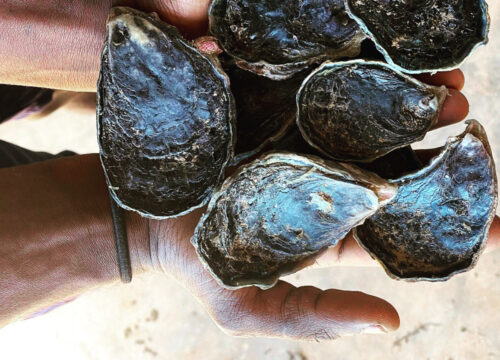
- Author Samantha J. Nowland & Brien H. Roberts
- Publish date 4 July 2023
- Aquaculture
Summary
The blacklip rock oyster, Saccostrea lineage J, has the potential to support new aquaculture developments throughout its range in the tropical Indo-Pacific region, but lack of research investment in understanding basic biology has been a key failure point in the past. This study assessed Saccostrea lineage J spat growth and survival in downweller and upweller nursery systems, with the aim of establishing baseline biological information and evaluating spat performance to support commercialisation efforts. Downweller and upweller nursery systems were similarly effective at rearing spat, with mean dorsoventral measurement in both systems reaching a 5 mm deployment size at 59 days post hatch. Growth rates reported in this study of 0.19 and 0.20 mm day−1 in the downweller and upweller, respectively, are comparable to other hatchery-produced tropical and subtropical bivalve spat. Based on the results of this study, it is recommended that spat be held in nurseries for approximately two months to reach a 5 mm deployment size. The information obtained in this study is the first documentation of Saccostrea lineage J spat growth and survival, and the methods used provide a basis for commercial production of this species.
**The Version of Scholarly Record of this Article is published in Molluscan Research 2023 and is available online at: https://www.tandfonline.com/doi/full/10.1080/13235818.2023.2217677
To cite this article: Samantha J. Nowland & Brien H. Roberts (2023) Assessment of blacklip rock oyster, Saccostrea lineage J, spat growth and survival in recirculating upweller and downweller nursery systems, Molluscan Research, 43:2, 101-108, DOI: 10.1080/13235818.2023.2217677
Projects
Northern Territory Tropical Rock Oyster research and development
This project establishes a collaborative cross-jurisdictional approach to address the most significant technical and regulatory issues which are confronting northern Australia’s fledgling Tropical Rock Oyster (TRO) industry. The project work will be conducted by research teams in Western Australia (A.2.1819053WA) and the Northern Territory and include three sub-projects addressing the different research needs identified. These are outlined below. Sub-Project 1 – Species Identification, Pathogen Screening and Translocation Risk assessment (NT) This research will standardise oyster common names and assess the need for farming and translocation zones across NA. It will consider risks associated with genetic pollution of wild populations, existing information on tropical ecosystems and oyster diseases, experiences from the pearl industry, and existing practice in edible oyster aquaculture in other regions of Australia. This information will provide a strong science base for biosecurity planning, management and operating procedures for the developing industry and determine key issues for further research and development. Sub-Project 2 – Securing commercial spat (juvenile) supply Early hatchery development work in the NT and WA indicates Tropical Rock Oysters have different larval requirements to the well-studied and already commercially produced Sydney Rock Oyster (SRO) and Pacific Oyster (PO). Therefore, the hatchery manuals developed for SRO’s and PO’s are not effective in producing commercial quantities of TRO spat. Researchers will utilise existing hatchery infrastructure and expertise at the Darwin Aquaculture Centre to refine culture techniques for the Blacklip Rock Oyster. Hatchery trials will be conducted to refine and improve larval settlement procedures and will include experiments on different salinities, the timing of settlement and the effectiveness of chemical and substrate settlement cues. Work on conditioning broodstock within the hatchery and investigating which hatchery systems work best will also form part of this sub-project Sub-Project 3 – Optimisation of grow-out methods and gear technology This Sub-Project will investigate optimised grow-out methods and gear technology for the production of Blacklip Rock Oyster. Farming trials will be conducted using intertidal systems at two sites: South Goulburn Island (supported by the Yagbani Aboriginal Corporation) and Groote Eylandt ( supported by the Anindilyakwa Land Council). The two trials will include: Trial 1 will use one manufacturer type to investigate the effect of three different basket heights in the tidal range (standard, low and dynamic) and density (standard and half of standard) of oysters in baskets on growth and survival of oysters and the biofouling of the baskets. Growth rates, shell shape, survival and biofouling will be recorded. Trial 2 will compare the performance of different gear types in producing marketable Blacklip Rock Oysters. This trial will provide data on oyster growth and shape and qualitative information on the operation, maintenance and performance of the different systems.


